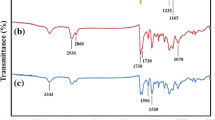Abstract
Multifunctional new material—polyurethane shape memory polymer (PU-SMP)—was subjected to tension carried out at room temperature at various strain rates. The influence of effects of thermomechanical couplings on the SMP mechanical properties was studied, based on the sample temperature changes, measured by a fast and sensitive infrared camera. It was found that the polymer deformation process strongly depends on the strain rate applied. The initial reversible strain is accompanied by a small drop in temperature, called thermoelastic effect. Its maximal value is related to the SMP yield point and increases upon increase of the strain rate. At higher strains, the stress and temperature significantly increase, caused by reorientation of the polymer molecular chains, followed by the stress drop and its subsequent increase accompanying the sample rupture. The higher strain rate, the higher stress, and temperature changes were obtained, since the deformation process was more dynamic and has occurred in almost adiabatic conditions. The constitutive model of SMP valid in finite strain regime was developed. In the proposed approach, SMP is described as a two-phase material composed of hyperelastic rubbery phase and elastic-viscoplastic glassy phase, while the volume content of phases is specified by the current temperature.











Similar content being viewed by others
References
W.M. Huang, B. Young and Y.Q. Fu, Polyurethane Shape Memory Polymers, CRC Press Taylor & Francis Group, 2012, p 31–50
H. Tobushi, R. Matsui, K. Takeda, and E.A. Pieczyska, Mechanical Properties of Shape Memory Materials. Materials Science and Technologies. Mechanical Engineering Theory and Applications, NOVA Publishers, New York, 2013
S. Hayashi, Properties and Applications of Polyurethane-Series Shape Memory Polymer, Int. Prog. Urethanes, 1993, 6, p 90–115
H. Tobushi, E.A. Pieczyska, Y. Ejiri, and T. Sakuragi, Thermomechanical Properties of Shape Memory Alloy and Polymer and their Composite, Mech. Adv. Mater. Struct., 2009, 16, p 236–247
E.A. Pieczyska, W.K. Nowacki, H. Tobushi, and S. Hayashi, Thermomechanical Properties of Shape Memory Polymer Subjected to Tension in Various Conditions, QIRT J., 2010, 6, p 189–205
H.J. Qi and M.C. Boyce, Stress-Strain Behavior of Thermoplastic Polyurethanes, Mech. Mater., 2005, 37, p 817–839
T. Takahashi, N. Hayashi, and S. Hayashi, Structure and Properties of Shape-Memory Polyurethane Block Copolymers, J. Appl. Polym. Sci., 1996, 60, p 1061–1069
K. Ito, K. Abe, H.-L. Li, Y. Ujihira, N. Ishikawa, and S. Hayashi, Variation of Free Volume Size and Content of Shape Memory Polymer-Polyurethane-Upon Temperature Studied by Positron Annihilation Lifetime Techniques and Infrared Spectroscopy, J. Radioanal. Nucl. Chem., 1996, 211, p 53–60
B.K. Kim, S.Y. Lee, and M. Xu, Polyurethanes Having Shape Memory Effects, Polymer, 1996, 37, p 5781–5793
M. Alexandru, M. Cazacu, M. Cristea, A. Nistor, C. Grigoras, and B.C. Simionescu, Poly(siloxane-urethane) Crosslinked Structures Obtained by Sol-Gel Technique, J. Polym. Sci. Part B, 2011, 49, p 1708–1718
W. Thomson, (Lord Kelvin). Quart. J. Pure and Appl. Math, 1, 57, 1857; Math. and Phys. Papers, v.1, 291, 1882
E.A. Pieczyska, Thermoelastic Effect in Austenitic Steel Referred to Its Hardening, J. Theor. Appl. Mech., 1999, 37(2), p 349–368
E.A. Pieczyska, S.P. Gadaj, W.K. Nowacki, Thermoelastic and Thermoplastic Effects Investigated in Steel, Polyamide and Shape Memory Alloys, Proc. of SPIE, Thermosense XXIV, USA, 4710, 2002, p 479–497
E.A. Pieczyska, S.P. Gadaj, and W.K. Nowacki, Temperature Changes in Polyamide Subjected to Tensile Deformation, Infrared Phys. Technol., 2002, 43(3-5), p 183–186
W. Oliferuk, M. Maj, R. Litwinko, and L. Urbański, Thermomechanical Coupling in the Elastic Regime and Elasto-Plastic Transition During Tension of Austenitic Steel, Titanium and Aluminium Alloy at Strain Rates from 10-4 to 10-1 s-1, Eur. J. Mech. A Solids, 2012, 35, p 111–118
T.D. Nguyen, C.M. Yakacki, P.D. Brahmbhatt, and M.L. Chambers, Modeling the Relaxation Mechanisms of Amorphous Shape Memory Polymers, Adv. Mater., 2010, 22, p 3411–3423
H.J. Qi, T.D. Nguyen, F. Castro, ChM Yakacki, and R. Shandas, Finite Deformation Thermomechanical Behavior of Thermally Induced Shape Memory Polymers, J. Mech. Phys. Solids, 2008, 56, p 1730–1751
P. Gilormini and J. Diani, On Modeling Shape Memory Polymers as Thermoelastic Two-Phase Composite Materials, C .R. Mechanique, 2012, 340, 338–348
K. Kowalczyk-Gajewska and H. Petryk, Sequential Linearization Method for Viscous/Elastic Heterogeneous Materials, Eur. J. Mech. A Solids, 2011, 30, p 650–664
S. Mercier, A. Molinari, S. Berbenni, and M. Berveiller, Comparison of Different Homogenization Approaches for Elastic-Viscoplastic Materials, Modelling Simul. Mater. Sci. Eng., 2012, 20, p 024004
H. Tobushi, T. Hashimoto, S. Hayashi, and E. Yamada, Thermomechanical Constitutive Modelling in Shape Memory Polymer of Polyurethane Series, J. Intell. Mater. Syst. Struct., 1997, 8, p 711–718
H. Tobushi, H.K. Okumura, S. Hayashi, and N. Ito, Thermomechanical Constitutive Model of Shape Memory Polymer, Mech. Mater., 2001, 33, p 545–554
J. Korelc, Automation of Primal and Sensitivity Analysis of Transient Coupled Problems, Comput. Mech., 2009, 44, p 631–649
B. Wcisło, J. Pamin, and K. Kowalczyk-Gajewska, Gradient-Enhanced Damage Model for Large Deformations of Elastic-Plastic Materials, Arch. Mech., 2013, 65(5), p 407–428
Acknowledgments
The research has been carried out with the support of the Polish National Center of Science under Grant No. 2011/01/M/ST8/07754 and (JSPS), Grant-in-Aid for Scientific Research (C) under No. 23560103. Authors thank Michal Majewski, a student of Warsaw University of Technology, for his contribution to graphical presentation of results.
Author information
Authors and Affiliations
Corresponding author
Additional information
This article is an invited paper selected from presentations at the International Conference on Shape Memory and Superelastic Technologies 2013, held May 20-24, 2013, in Prague, Czech Republic, and has been expanded from the original presentation.
Rights and permissions
About this article
Cite this article
Pieczyska, E.A., Maj, M., Kowalczyk-Gajewska, K. et al. Mechanical and Infrared Thermography Analysis of Shape Memory Polyurethane. J. of Materi Eng and Perform 23, 2553–2560 (2014). https://doi.org/10.1007/s11665-014-0963-2
Received:
Revised:
Published:
Issue Date:
DOI: https://doi.org/10.1007/s11665-014-0963-2




